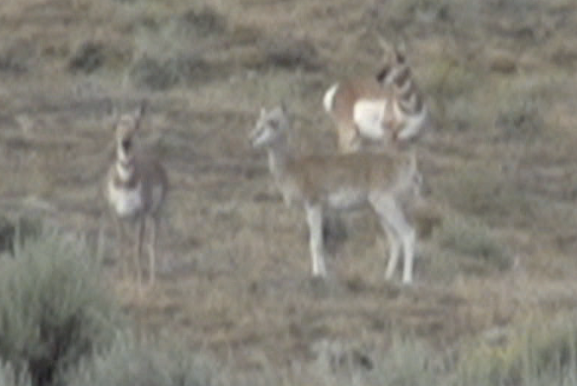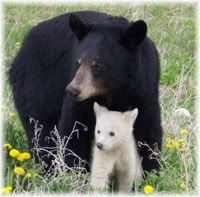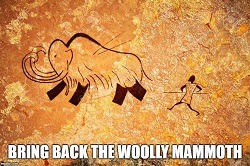



 The Accurate Reloading Forums
The Accurate Reloading Forums  THE ACCURATE RELOADING.COM FORUMS
THE ACCURATE RELOADING.COM FORUMS  Hunting
Hunting  American Big Game Hunting
American Big Game Hunting  albino antelope
albino antelopeGo  | New  | Find  | Notify  | Tools  | Reply  |  |
| One of Us |
 i posted this picture on another thread but the thread is old and i'm not sure everyone would get to see it. so reposting here,enjoy its the only albino antelope i've ever seen and i missed her at 300 yds. | ||
|
one of us |
How did you verify it was an albino? Could you see pink eyes and white hooves? Just curious. Ted Kennedy's car has killed more people than my guns | |||
|
| One of Us |
i looked at her in the glasses briefly and went to the gun. she's something other than normal coloration and i got 2 doe tags for the area. i'm looking for her,and may be able to better answer your q's in about 30 days | |||
|
| one of us |
Wyoming has a rifle season for Antelope in July???? Don't let so much reality into your life that there's no room left for dreaming. | |||
|
| One of Us |
i shot at this one last year | |||
|
| one of us |
Ah. Don't let so much reality into your life that there's no room left for dreaming. | |||
|
| One of Us |
Does not look all white to me.Looks brown. | |||
|
one of us |
With the photo at hand, I'd vote "rare" or "odd" in lieu of albino. Nonetheless, still different and interesting. Ted Kennedy's car has killed more people than my guns | |||
|
| one of us |
Interestingly enough, there was a program on the other day about albino-ism. Albino doesn't technically mean solid white, there can still be some pale hues and shading. It's the lack of pigment in the eyes (the pink eyes) that determine if it's truly an albino or just pale. ____________________________ If you died tomorrow, what would you have done today ... 2018 Zimbabwe - Tuskless w/ Nengasha Safaris 2011 Mozambique - Buffalo w/ Mashambanzou Safaris | |||
|
| One of Us |
Melanistic? ______________________ I don't shoot elk at 600 yards for the same reasons I don't shoot ducks on the water, or turkeys from their roosts. If this confuses you then you're not welcome in my hunting camp. | |||
|
| One of Us |
Melanistic would be black.....I say piebald. ________________________________________________ Maker of The Frankenstud Sling Keeper Proudly made in the USA Acepting all forms of payment | |||
|
| One of Us |
We have piebald deer around here.They can be all white or patched brown and white.The patches seem to be more definite and not blended in.I think that Antelope well being different, is neither piebald or albino.Of course that is only my opinion. | |||
|
one of us |
I have a buck antelope on my wall that is predominantly white with faded color. Looks nice to me but not an albino. If he had pink eyes when he was alive, they turned brown when he hit the ground. Ted Kennedy's car has killed more people than my guns | |||
|
| One of Us |
i'm pretty sure its not piebald, and i only descibe it as albino cause its white where it should be brown and has no black at all its defenitly different and like i said i've got 2 doe tags for the area and i'll be looking specifically for her come sept. 1st. i'll take a bunch of pictures if i "find" her and share them here.wish me luck..... | |||
|
one of us |
GOOD LUCK! Ted Kennedy's car has killed more people than my guns | |||
|
| One of Us |
It might be leucistic. From Wiki: Leucism (occasionally spelled leukism) is a general term for the phenotype resulting from defects in pigment cell differentiation and/or migration from the neural crest to skin, hair or feathers during development. This results in either the entire surface (if all pigment cells fail to develop) or patches of body surface (if only a subset are defective) having a lack of cells capable of making pigment. Since all pigment cell-types differentiate from the same multipotent precursor cell-type, leucism can cause the reduction in all types of pigment. This is in contrast to albinism, for which leucism is often mistaken. Albinism results in the reduction of melanin production only, though the melanocyte (or melanophore) is still present. Thus in species that have other pigment cell-types, for example xanthophores, albinos are not entirely white, but instead display a pale yellow colour. More common than a complete absence of pigment cells is localized or incomplete hypopigmentation, resulting in irregular patches of white on an animal that otherwise has normal colouring and patterning. This partial leucism is known as a "pied" or "piebald" effect; and the ratio of white to normal-coloured skin can vary considerably not only between generations, but between different offspring from the same parents, and even between members of the same litter. This is notable in horses, cows, cats, dogs, the urban crow[1] and the ball python[2] but is also found in many other species. A further difference between albinism and leucism is in eye colour. Due to the lack of melanin production in both the retinal pigmented epithelium (RPE) and iris, albinos typically have red eyes due to the underlying blood vessels showing through. In contrast, leucistic animals have normally coloured eyes. This is because the melanocytes of the RPE are not derived from the neural crest, instead an outpouching of the neural tube generates the optic cup which, in turn, forms the retina. As these cells are from an independent developmental origin, they are typically unaffected by the genetic cause of leucism. Genes that, when mutated, can cause leucism include, c-kit,[3] mitf[4] and ednrb.[5] ~Ann  | |||
|
| One of Us |
Geez thanks for explaining that Ann.it`s perfectly clear now!!! | |||
|
| One of Us |
Sorry Olbiker, I didn't mean it to be confusing. I'm by far no expert in genetic terminology either, I am always studying as a poultry breeder (Chicken genetics really suck!). An easier way to visualize this: think of the word Phenotype to mean the way something looks as you see it. Loosely defined: If something is pink and you see that it is pink, that is the Genotype. It may have plenty of genes (Genotype) that could make it look a variety of colors but what you actually see is the Phenotype. Genotype, is of course, what genes something posesses. You don't always 'see' what the genes are but they can show up in later offspring. So back to Phenotype and the way something looks... Leucistic is sort of the opposite of melanistic. Some animals may look white or really light in color but still have normal colored eyes and skin. They are not albinos, which lack Melanin (normal skin pigments), which have visible pink skin and eyes. Melanistic refers to overly dark pigmentation, like black squill, all black deer, etc. Hope this helps explain: The pictured pronghorn seems lighter in color than normal, certainly not much white hair showing where most female antelope bear white patches. It might be odd, such as being leucistic, or, just might be totally normal and just has very little white hair. Maybe it is diseased, etc. No one will know for sure unless a close up look is taken. So what can we say? Well, it is clearly NOT melanistic, NOT of normal phenotype (tan and white female) and is probably NOT albino. ~Ann  | |||
|
| One of Us |
Much better | |||
|
| One of Us |
thanks Ann, great information. | |||
|
| One of Us |
| |||
|
| One of Us |
Maybe not a real albino, but cleaned up will be a very interesting trophy. Congratulations to the lucky hunter. Even the rocks don't last forever. | |||
|
| Powered by Social Strata |
| Please Wait. Your request is being processed... |
|

Visit our on-line store for AR Memorabilia

